Getting a tattoo is an exciting personal choice that requires careful thought and planning. An important but often overlooked part of the process is the tattoo consent form. While usually not legally required, a tattoo consent form covers important information to protect the client and artist. This agreement confirms the client is of legal age, understands the risks and aftercare, and gives their full approval for the specific tattoo plan.
For the artist, the consent form documents the consultation was thorough and the client is ready to proceed. Having a clear record of agreement on the design, placement, cost, and process can prevent misunderstandings. This article provides a guide to tattoo consent forms including what to cover, why they’re useful for all parties, and free customizable templates. With a comprehensive form, clients can feel fully informed while artists create a paper trail showing proper protocol was followed. A smooth tattoo experience starts with mutual understanding.
Table of Contents
What Is a Tattoo Consent Form?

A tattoo consent form is a written agreement between the client and tattoo artist that outlines important details and mutual understanding regarding the planned tattoo. It confirms the client is of legal age, has been informed of potential health risks like infection or allergic reaction, understands proper aftercare, and gives full consent to the artist to perform the tattoo.
The form records key specifics like the exact design, placement on the body, number of sessions needed, and total cost estimated by the artist. It also usually includes legal releases protecting the artist and waivers of liability. Having this documentation protects both parties by ensuring the client makes an informed decision and gives explicit approval for the agreed-upon tattoo. For the artist, it shows diligence was taken to get full consent.
Tattoo Consent Form Templates
Getting a tattoo is an exciting decision that requires careful thought. A tattoo consent form covers important health, legal and procedural information before getting inked. A consent form template allows tattoo parlors to create a customized form easily.
The template provides the standard consent form sections, including client info, tattoo description, risks, and a liability waiver. Customize it by adding your tattoo shop’s logo and branding it with your own colors and fonts. You can include specific procedural details like ink colors and aftercare guidance.
A tattoo consent form template lets you generate a consistent professional form for each client. Customize the template with the client name, tattoo details, and e-signature before printing. A comprehensive tattoo consent form shows you run a safe, transparent tattoo business. It informs your clients and protects you from liability. With a consent form template, preparing for a new tattoo is simple for both artist and client.
Why Do You Need A Tattoo Consent Form?
It acts as a written agreement that ensures both parties are aware of the risks, processes, and other relevant aspects of the tattooing procedure. Here are detailed reasons outlining the importance of a tattoo consent form:
Legal Protection for Tattoo Artists and Studios:
- Liability: The primary purpose of the consent form is to protect the tattoo artist and the studio from potential legal disputes. If a client later claims they were unaware of the risks associated with getting a tattoo, the signed consent form can be used as evidence that the client was indeed informed.
- Age Verification: It’s illegal in many regions to tattoo someone under a specific age (usually 18). The consent form often requires clients to attest to their age, protecting the artist from accidental legal breaches.
Informed Client Decision:
- Understanding Risks: The consent form outlines potential risks associated with tattooing, including allergic reactions, scarring, and infections. This ensures clients are making an informed decision about their body.
- Aftercare Responsibilities: The healing of a tattoo largely depends on proper aftercare. The consent form can detail aftercare procedures, making clients aware of their responsibilities post-tattoo.
Health and Medical Considerations:
- Medical History: The form may ask about the client’s medical history, including allergies (especially to ink components or latex), skin disorders, or other relevant health conditions. This information helps the artist determine if tattooing is safe for the client.
- Medications: Some medications can affect the tattooing process, especially those that thin the blood. By inquiring about medications, the artist can make necessary adjustments or postpone the tattooing session.
Clarity on Tattoo Details:
- Design Confirmation: The form can include a section where the client confirms the design, size, location, and colors of the tattoo. This minimizes misunderstandings and potential dissatisfaction later on.
- Pricing and Payment: The form can clarify the agreed-upon price, preventing disputes related to payment.
Setting Expectations:
- Studio Policies: The consent form can provide information on studio policies, such as touch-up sessions, cancellations, and refunds.
- Tattoo Lifespan: The form can explain that tattoos can fade over time and may require maintenance. This helps set realistic expectations for the client.
Documentation of Consent:
- Explicit Permission: For more sensitive or potentially controversial tattoo placements or designs, the consent form serves as explicit evidence that the client provided clear permission for the specific tattoo.
What Information Should Be Included On A Tattoo Consent Form?
A tattoo consent form should thoroughly capture all important details and agreements between the client and artist. This ensures total transparency and understanding before the process begins. Here are some of the key elements the form should contain:
- Tattoo Studio and Artist Information:
- Name of the studio and/or tattoo artist.
- Studio’s physical address, contact number, and email address.
- Any relevant certification or licensing information.
- Client’s Personal Information:
- Full name.
- Address.
- Contact number and email.
- Date of birth (to confirm legal age).
- A copy or details of a valid ID, like a driver’s license or passport, for verification.
- Tattoo Specifics:
- Description of the tattoo design.
- Approximate size and location on the body.
- Colors to be used, if applicable.
- Estimated duration of the tattooing session.
- Medical Information:
- A section for the client to disclose any allergies, especially to inks or other tattooing materials.
- Any existing skin conditions or concerns.
- Current medications, as some may interfere with the tattoo healing process or increase bleeding.
- Recent alcohol or drug use (as these can affect pain perception and bleeding).
- Procedure Risks and Side Effects:
- Detailed list of potential risks, including pain, swelling, allergic reactions, infections, and scarring.
- Information about the possibility of dissatisfaction with the final outcome.
- Explanation that results, including final colors, can vary based on skin type, aftercare, and other factors.
- Aftercare Information:
- Recommendations for cleaning and protecting the new tattoo.
- Information about signs of infections or complications.
- Possible need for touch-ups or follow-up appointments.
- Liability Waiver and Acknowledgment:
- A statement where the client acknowledges understanding the risks and accepts them.
- A waiver wherein the client releases the tattoo artist and studio from any liability should complications arise.
- Statement confirming that the client is not under the influence of drugs or alcohol, making the decision with a clear mind.
- Confirmation of Age and Consent:
- A statement confirming the client is of the legal age to get a tattoo.
- For minors, a section for parental consent, possibly requiring notarization.
- Payment and Refund Policies:
- Details about the cost of the tattoo.
- Deposit amount and conditions for refund, if applicable.
- Payment methods accepted.
- Signatures and Date:
- Space for the client to sign, indicating their understanding and consent.
- Space for the tattoo artist or studio representative to sign, confirming they’ve provided the necessary information.
- Date of signing.
Types Of Tattoo Release Forms
There are a few different types of tattoo consent and release forms used to document agreement between the client and artist. Here are some of the most common types:
Tattoo Procedure Consent Form
This form is one of the most basic yet vital documents in the tattooing process. Before a client receives a tattoo, they’re typically required to read and sign this form. It outlines the general procedures to be followed, any potential risks and complications associated with the tattooing process, and usually an acknowledgment from the client that they are of legal age and making the decision of their own free will. The form protects the tattoo studio from legal claims by ensuring clients understand what they’re consenting to.
Eyebrow Tattoo Consent Form
Given the delicate nature and visibility of facial tattoos, the eyebrow tattoo consent form is tailored specifically to microblading and other eyebrow tattooing techniques. This form describes the specific process of eyebrow tattooing, from the pigments used to the aftercare required. Clients are made aware of potential outcomes, including fading, color changes, and scarring. Furthermore, they are advised of the possible need for touch-ups and the importance of following aftercare guidelines to ensure the longevity and appearance of the tattoo.
Laser Tattoo Removal Form
Opting to remove a tattoo is a significant decision and involves a different set of risks and procedures than applying one. The laser tattoo removal form is used to ensure that clients understand the laser removal process, potential side effects, and expected outcomes. It might mention potential pain, possible skin discoloration, and the number of sessions required for complete removal. The form also ensures clients are aware that results can vary and that complete removal isn’t guaranteed.
Notarized Minor Consent Form or Tattoo Parental Consent
While the legal age to get a tattoo varies by region, many places allow minors to get tattoos with parental consent. This form serves as an official document wherein parents or guardians give their permission for their minor child to receive a tattoo. To ensure its authenticity and prevent forgery, the form is often notarized. It not only outlines the permission given by the guardian but also highlights the risks and responsibilities associated with tattooing a minor.
Permanent Tattoo Consent Form
A permanent tattoo, as opposed to a temporary one, lasts a lifetime. The permanent tattoo consent form serves as an acknowledgment from the client that they are opting for a permanent change to their body. This form will go into detail about the irreversible nature of the procedure, potential risks, and the importance of selecting a design and placement with long-term satisfaction in mind. It helps ensure clients have thoughtfully considered their decision and are not acting on impulse.
How To Write A Tattoo Consent Form?
Writing a tattoo consent form requires a methodical approach to ensure all the essential elements are covered. Here’s a step-by-step guide:
Step 1: Begin with the Basics
Start by including the name of the tattoo studio or artist, the address, and contact information at the top of the form. This establishes the official nature of the document and makes it specific to the studio or artist. A logo or other branding elements can also be included for added professionalism. Underneath this, leave space for the client’s name, address, date of birth, and contact information. It’s crucial to gather this data not only for record-keeping but also to establish the age and identity of the client.
Step 2: Outline the Procedure Details
In this section, detail the specifics of the tattoo procedure. This can include the location on the body where the tattoo will be placed, the size, the design or description, and the estimated duration of the tattoo session. If the procedure involves special techniques or considerations, such as microblading or color-packed tattoos, these should be included here. The goal is to ensure the client knows exactly what they are signing up for.
Step 3: Discuss Potential Risks and Side Effects
A well-informed client is a key to avoiding future disputes. In this section, clearly outline the potential risks and side effects associated with tattooing. This might encompass pain, swelling, allergic reactions, infections, scarring, and potential dissatisfaction with the final result. It’s also worth noting the variability in healing and that final colors and appearance may differ from initial expectations. By being transparent about these risks, you’re ensuring that clients are making an informed decision.
Step 4: Aftercare and Long-Term Considerations
This step is about ensuring the client understands their responsibility in the healing process and the permanence of the tattoo. Provide a brief overview of recommended aftercare procedures, stressing the importance of following them for the best healing and appearance of the tattoo. Additionally, emphasize the long-term nature of tattoos and that, while they can be removed or covered, they are inherently permanent and such procedures can be costly, painful, and might not restore the skin to its original appearance.
Step 5: Legal Acknowledgments and Liability Waiver
In this crucial section, include statements wherein the client acknowledges understanding the risks, accepts responsibility for any unforeseen complications, and releases the tattoo artist or studio from legal liability should any issues arise. This protects the artist or studio from potential lawsuits and ensures the client has been made fully aware of all possible outcomes.
Step 6: Final Signatures and Date
Conclude the form by leaving space for the client’s signature, the tattoo artist’s signature, and the date. This final step solidifies the agreement and serves as a binding acknowledgment of everything discussed in the form. For added security and legitimacy, consider having the form notarized, especially in cases where additional legal weight might be beneficial, such as tattooing minors with parental consent.
Conclusion
Getting inked is an exciting decision that requires careful consideration and preparation. An important part of the process is the tattoo consent form which protects client and artist alike by documenting full understanding and approval. With a comprehensive form outlining the design details, disclosure of risks, estimated cost, and release of liability, all parties can feel fully informed and confident moving forward.
To make the process smooth, we’ve provided printable, customizable tattoo consent form templates available for free download. Whether you are an artist looking to implement consent forms or a client looking to learn what to expect, these templates have you covered. With a complete tattoo agreement in place, you can focus on creating beautiful body art and memories that last a lifetime.
FAQs
Can minors sign their own Tattoo Consent Form?
In most regions, minors are not legally permitted to sign a Tattoo Consent Form on their own. Instead, they usually require a parent or guardian’s consent, often evidenced by a separate or included parental consent section on the form which may also need to be notarized.
Can I get a copy of the signed Tattoo Consent Form?
Yes, you have the right to request and receive a copy of any signed document, including a Tattoo Consent Form. It’s always a good idea to keep a copy for your records.
Is the Tattoo Consent Form legally binding?
Yes, the Tattoo Consent Form is a legally binding document. By signing it, you are agreeing to the terms outlined in the form, acknowledging the risks, and typically releasing the artist or studio from certain liabilities.
What if I change my mind after signing the consent form but before getting the tattoo?
Signing the form doesn’t obligate you to get the tattoo. If you change your mind before the procedure starts, inform the artist immediately. However, any deposits or fees you’ve paid might be subject to the studio’s refund policy.
Does the consent form cover touch-ups or corrections?
Some Tattoo Consent Forms might include terms related to touch-ups or corrections, while others might treat them as separate procedures requiring a new form or agreement. It’s essential to check the specific terms of the form you’re signing.
How long does the tattoo studio keep my signed consent form?
Retention periods can vary by studio and region. Generally, studios will keep signed consent forms for several years to maintain a record of the agreement and for potential legal reasons.







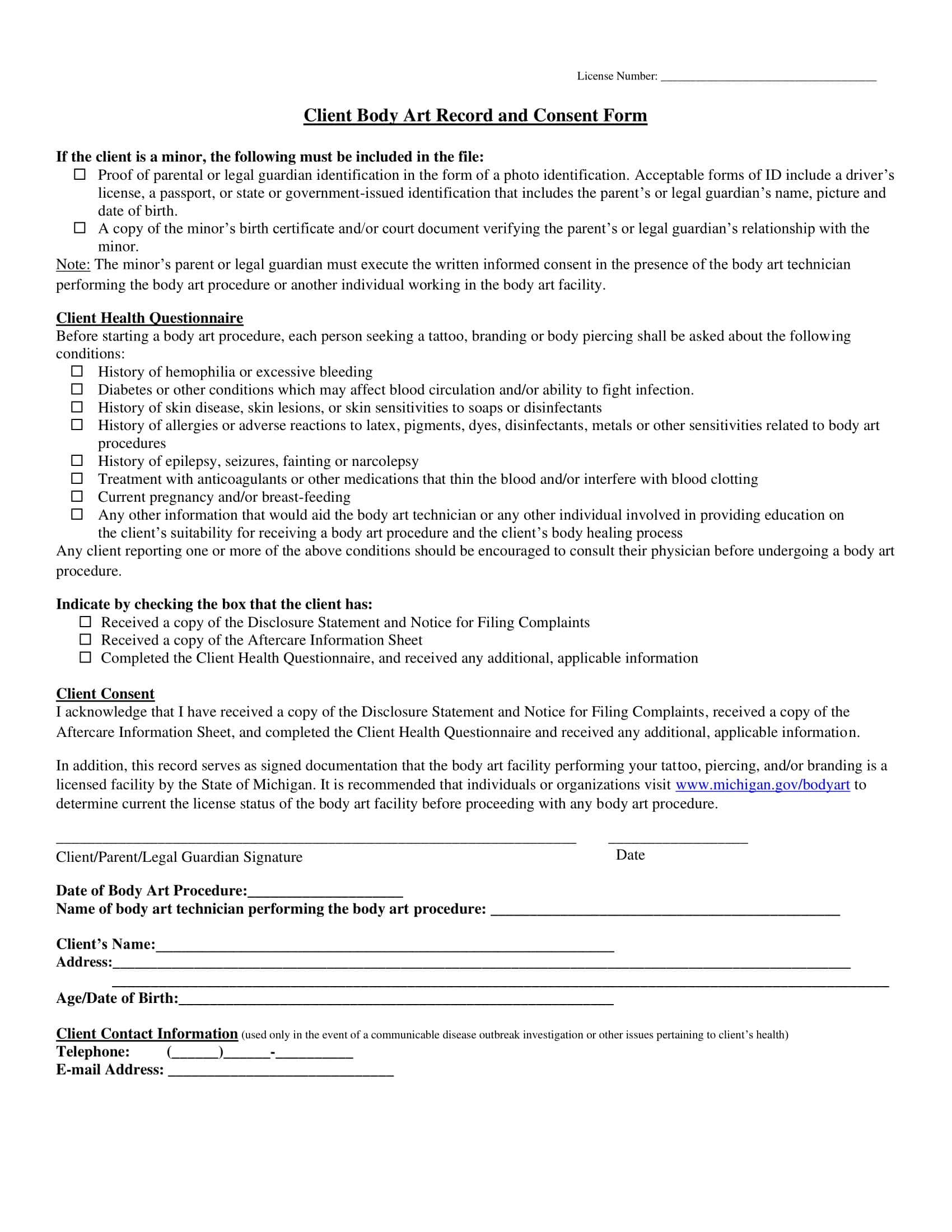
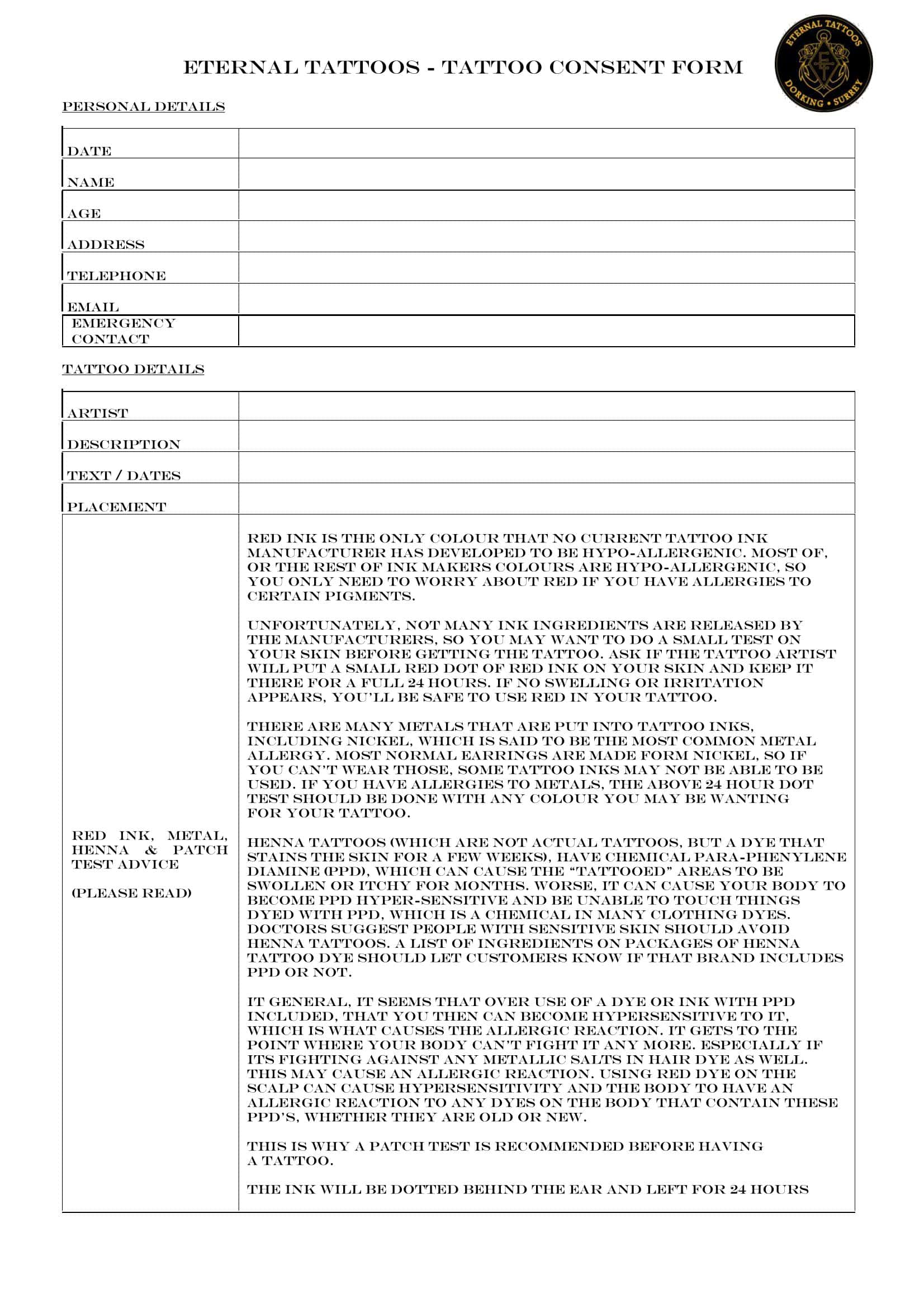


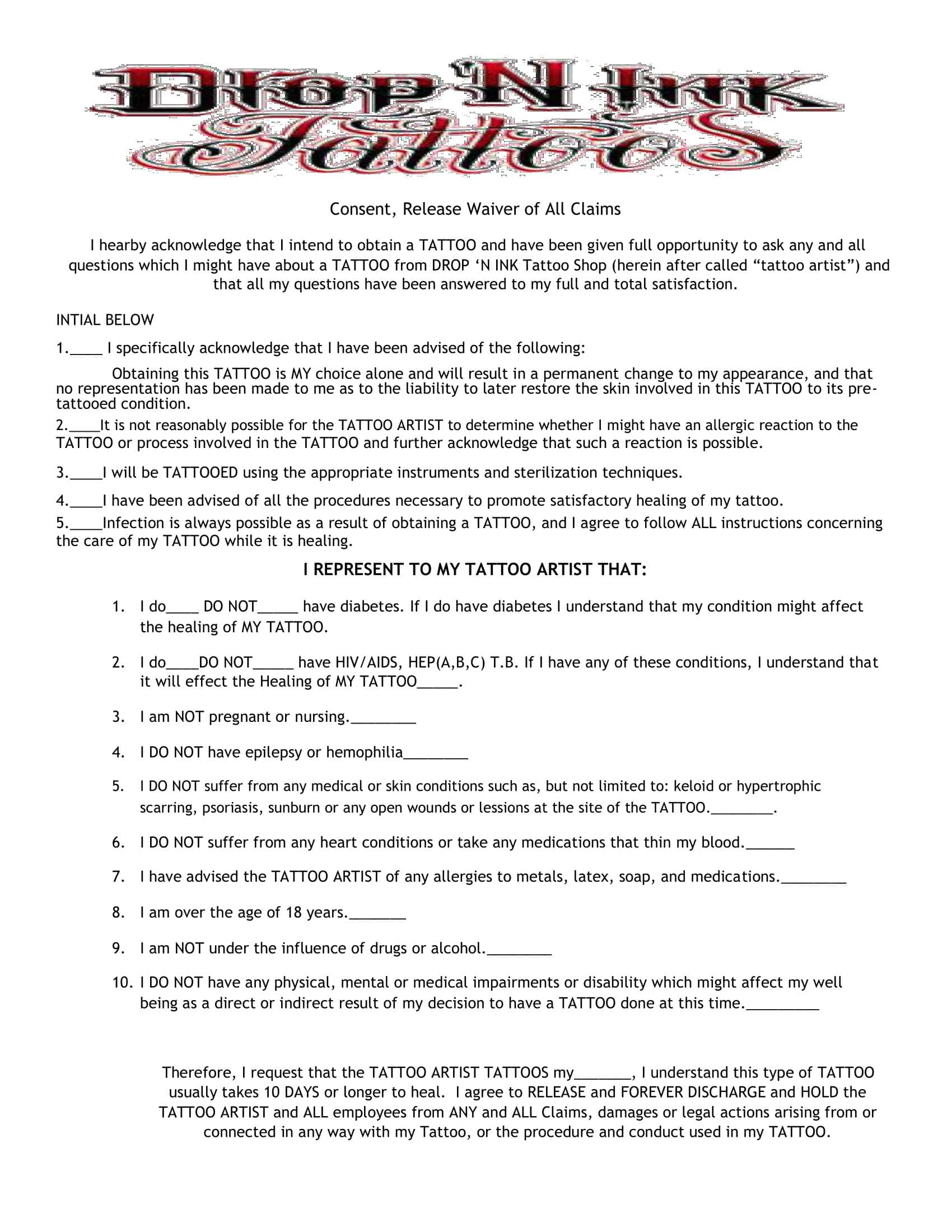



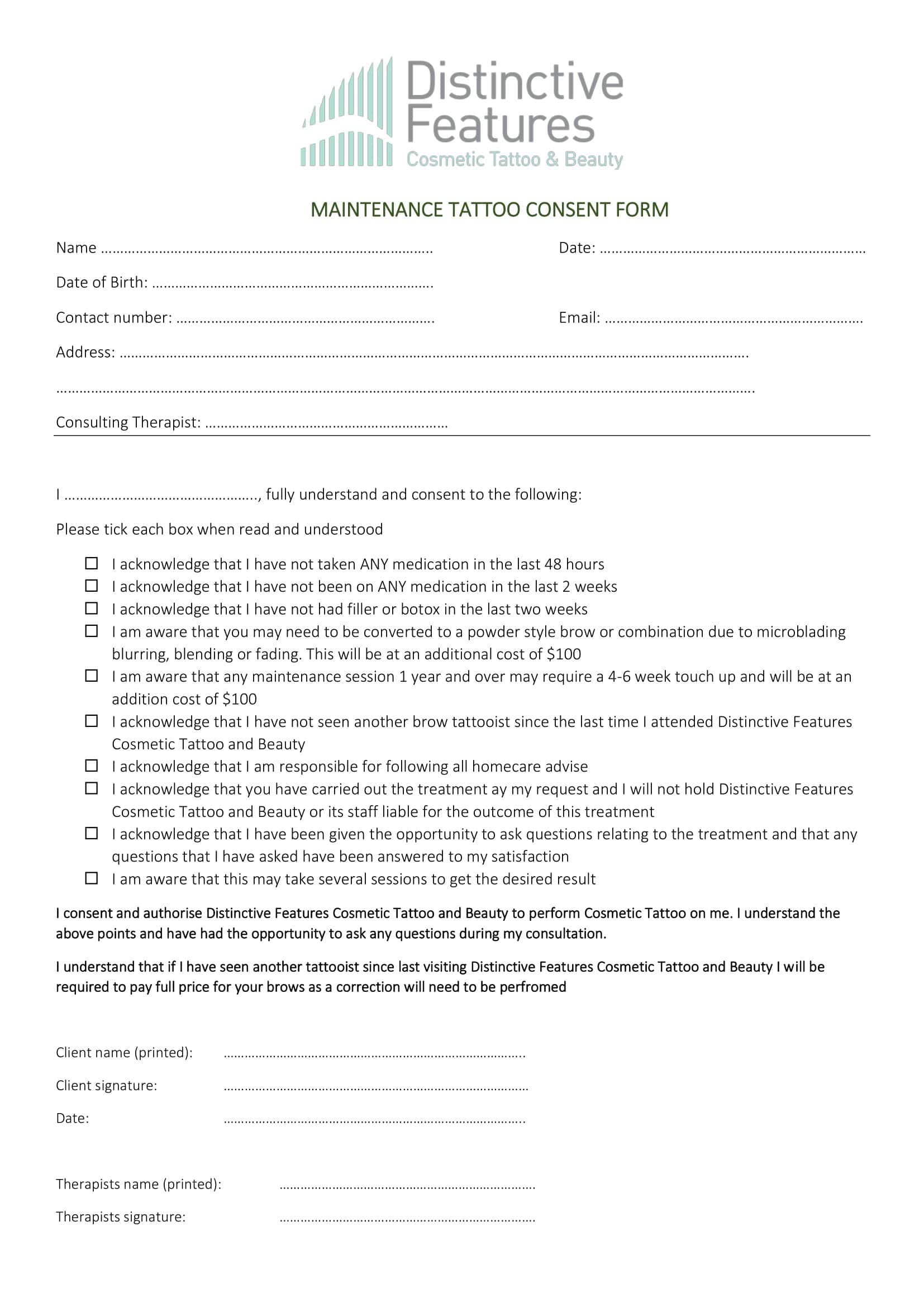
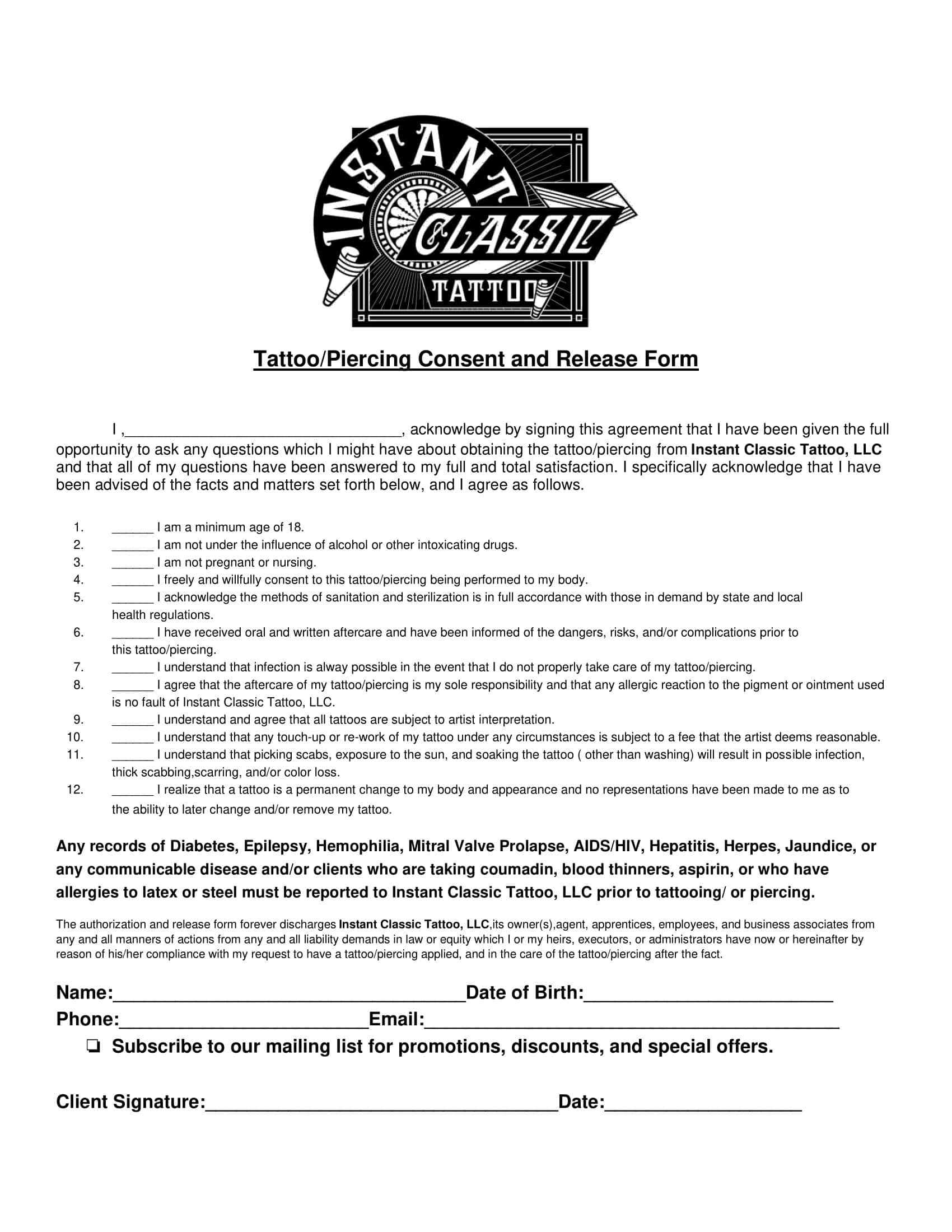






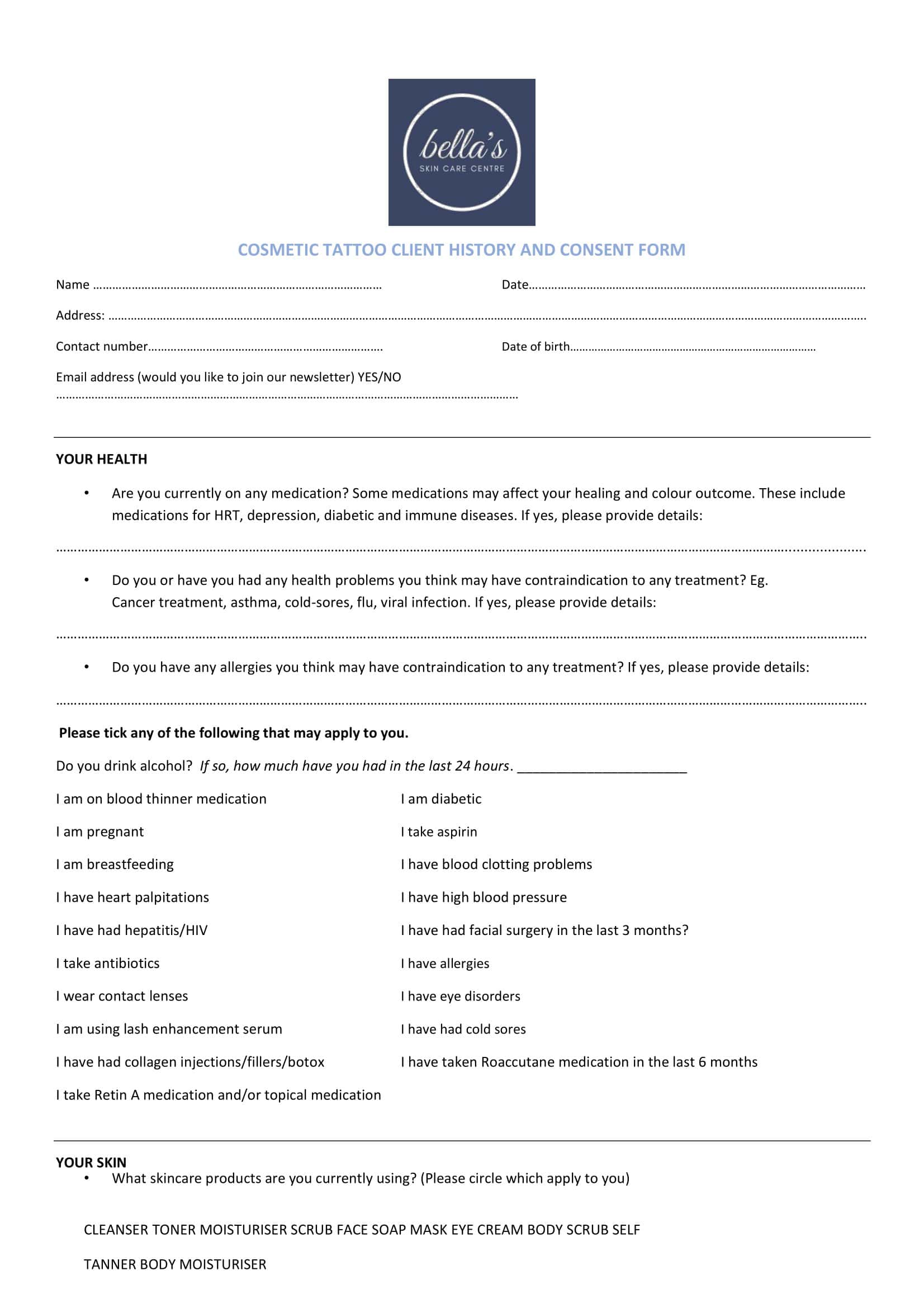
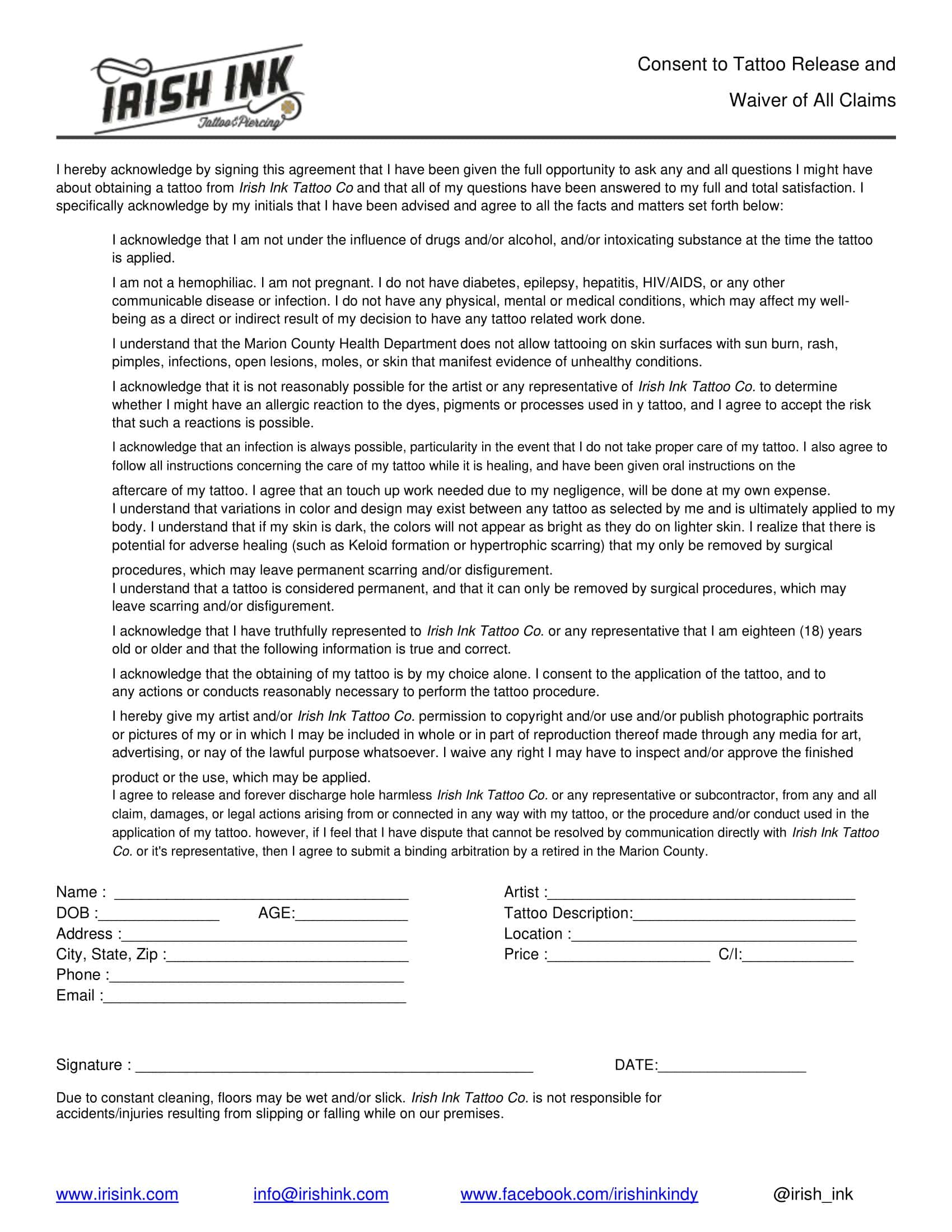

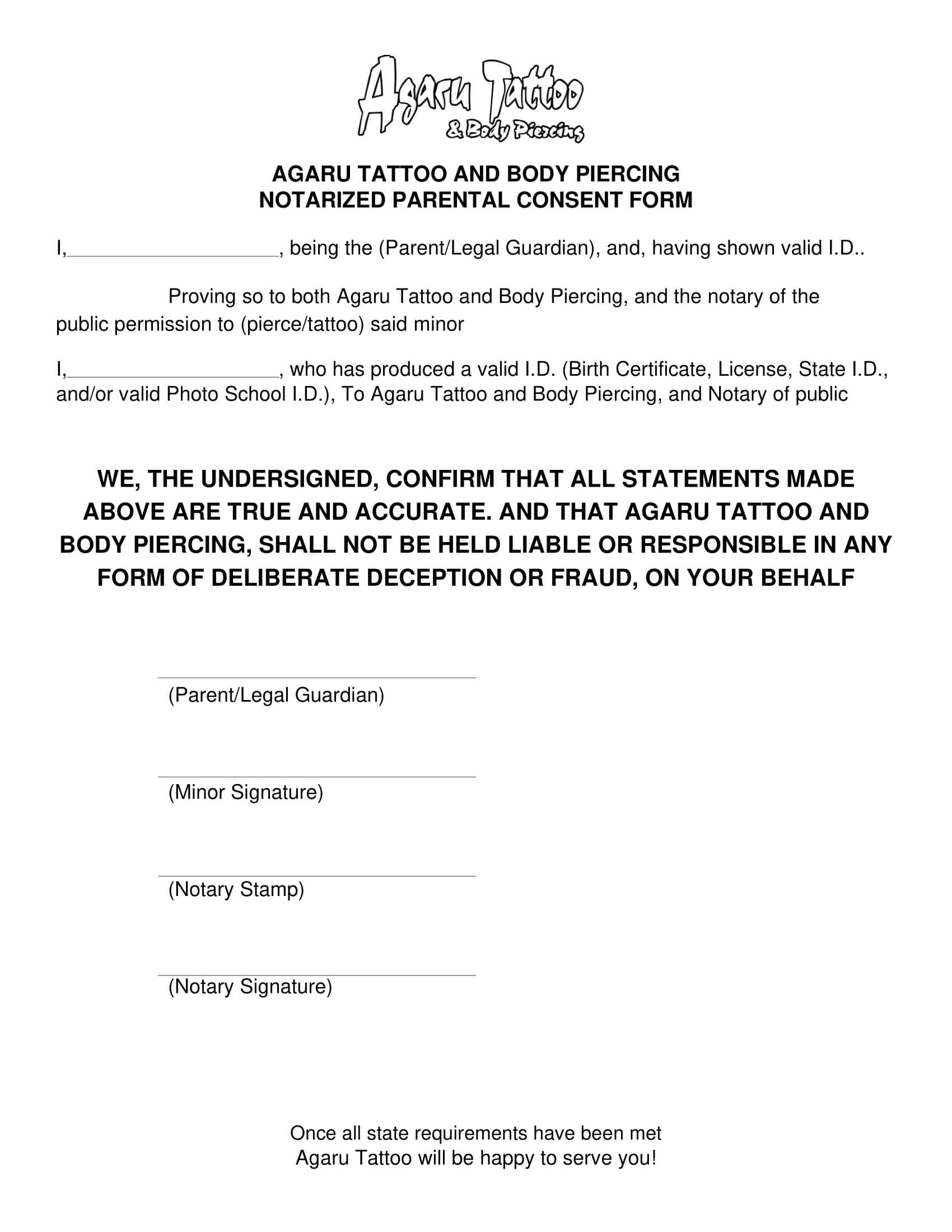
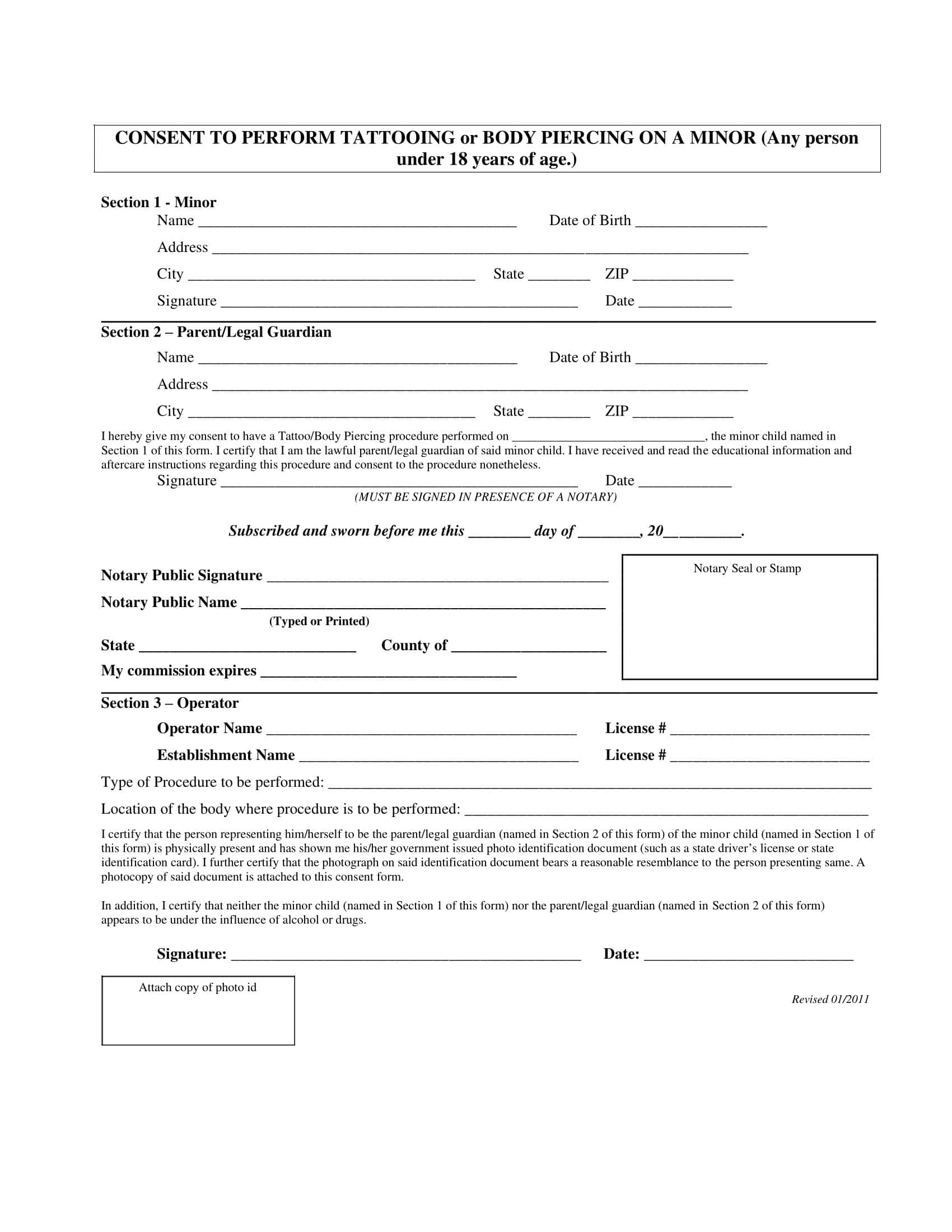






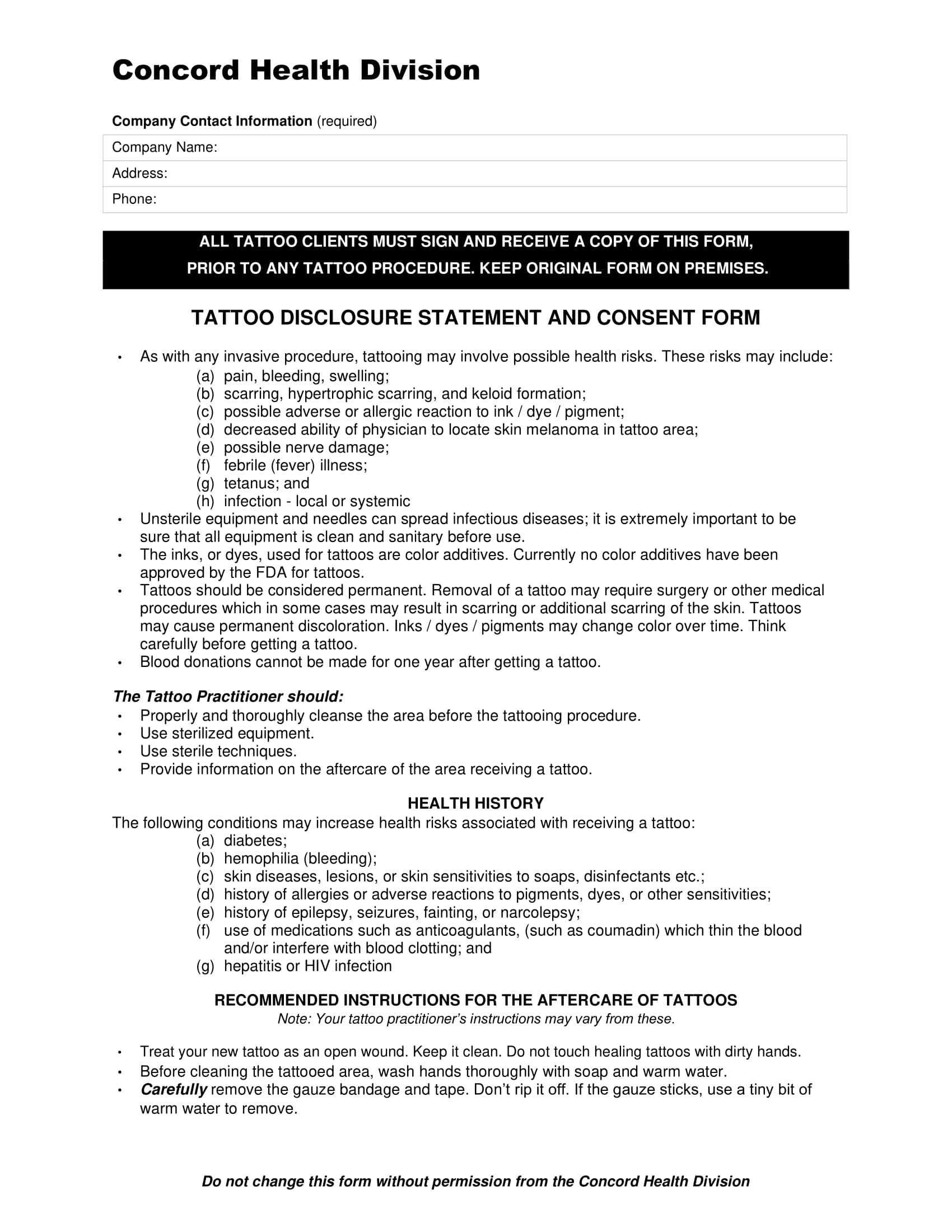





![Free Printable Parental Consent Form Templates [Travel, Passport] Word 1 Parental Consent Form](https://www.typecalendar.com/wp-content/uploads/2023/04/Parental-Consent-Form-150x150.jpg)
![Free Printable Location Release Form Templates [PDF, Word] Property / Example 2 Location Release Form](https://www.typecalendar.com/wp-content/uploads/2023/05/Location-Release-Form-1-150x150.jpg)
![Free Printable Talent Release Form Templates [PDF, Word, Excel] 3 Talent Release Form](https://www.typecalendar.com/wp-content/uploads/2023/05/Talent-Release-Form-1-150x150.jpg)
